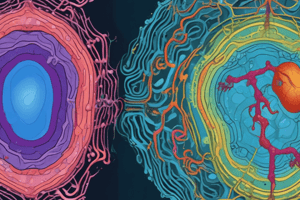Podcast
Questions and Answers
What is the main function of the cytoskeleton?
What is the main function of the cytoskeleton?
What type of filaments are desmin, keratin, and dystrophine?
What type of filaments are desmin, keratin, and dystrophine?
What is the function of lamins in the nuclear envelopment?
What is the function of lamins in the nuclear envelopment?
What is the function of histones in the nucleus?
What is the function of histones in the nucleus?
Signup and view all the answers
What is the main function of microtubules?
What is the main function of microtubules?
Signup and view all the answers
What is the primary function of the cytosol?
What is the primary function of the cytosol?
Signup and view all the answers
What is the function of the nuclear pores in the nuclear envelopment?
What is the function of the nuclear pores in the nuclear envelopment?
Signup and view all the answers
What is the function of chromatin?
What is the function of chromatin?
Signup and view all the answers
What is the primary function of the Na/K-ATPase protein in the plasmalemma?
What is the primary function of the Na/K-ATPase protein in the plasmalemma?
Signup and view all the answers
What is the main function of the smooth endoplasmic reticulum (sER)?
What is the main function of the smooth endoplasmic reticulum (sER)?
Signup and view all the answers
What is the role of the ribophorin protein in the rough endoplasmic reticulum (rER)?
What is the role of the ribophorin protein in the rough endoplasmic reticulum (rER)?
Signup and view all the answers
What is the primary function of euchromatin?
What is the primary function of euchromatin?
Signup and view all the answers
What is the primary function of the Golgi apparatus?
What is the primary function of the Golgi apparatus?
Signup and view all the answers
What is the function of the transferases enzymes in the smooth endoplasmic reticulum (sER)?
What is the function of the transferases enzymes in the smooth endoplasmic reticulum (sER)?
Signup and view all the answers
What is the role of facultative heterochromatin?
What is the role of facultative heterochromatin?
Signup and view all the answers
What is the primary function of the nucleolus?
What is the primary function of the nucleolus?
Signup and view all the answers
What is the role of the glycosyltransferase enzymes in the Golgi apparatus?
What is the role of the glycosyltransferase enzymes in the Golgi apparatus?
Signup and view all the answers
What is the function of the clathrin in the Golgi apparatus?
What is the function of the clathrin in the Golgi apparatus?
Signup and view all the answers
What is the difference between euchromatin and heterochromatin?
What is the difference between euchromatin and heterochromatin?
Signup and view all the answers
What is the final destination of the proteins synthesized in the rough endoplasmic reticulum (rER)?
What is the final destination of the proteins synthesized in the rough endoplasmic reticulum (rER)?
Signup and view all the answers
What is the function of constitutive heterochromatin?
What is the function of constitutive heterochromatin?
Signup and view all the answers
Where does the biogenesis of ribosomes take place?
Where does the biogenesis of ribosomes take place?
Signup and view all the answers
What is the main function of mitochondria in a cell?
What is the main function of mitochondria in a cell?
Signup and view all the answers
What is the characteristic of euchromatin?
What is the characteristic of euchromatin?
Signup and view all the answers
What is the function of facultative euchromatin?
What is the function of facultative euchromatin?
Signup and view all the answers
What is the function of the enzyme catalase in peroxisomes?
What is the function of the enzyme catalase in peroxisomes?
Signup and view all the answers
What is the term for the process of hydrolysis of already used components of the cell?
What is the term for the process of hydrolysis of already used components of the cell?
Signup and view all the answers
What is the function of protein H^+^ - ATPase in lysosomes?
What is the function of protein H^+^ - ATPase in lysosomes?
Signup and view all the answers
What is the function of free ribosomes in a cell?
What is the function of free ribosomes in a cell?
Signup and view all the answers
What is the function of the matrix of mitochondria?
What is the function of the matrix of mitochondria?
Signup and view all the answers
What is the term for the process of hydrolysis of foreign organic substances in lysosomes?
What is the term for the process of hydrolysis of foreign organic substances in lysosomes?
Signup and view all the answers
What is the function of proteases in lysosomes?
What is the function of proteases in lysosomes?
Signup and view all the answers
Study Notes
Cell Organelles
-
Plasmalemma (Cell Membrane): a biological barrier, transports substances, receives signals, connects cells, and has immunologic functions.
- Contains membranous proteins: Na/K-ATPase, Ca-ATPase, Aquaporine, Insuline receptor, LDL receptor, and Opsin.
Endoplasmic Reticulum (ER)
-
Smooth Endoplasmic Reticulum (sER): a membranous organelle with enzymes for lipid synthesis, detoxification of xenobiotics, and synthesizing proteins.
- Enzymes: synthetases, isomerases, and transferases.
-
Rough Endoplasmic Reticulum (rER): a membranous organelle with ribophorin, synthesizing proteins, and transporting them to the Golgi apparatus.
- Synthesizes proteins for: rER itself, lysosomes, Golgi apparatus, export, and cell membrane.
Golgi Apparatus
-
Golgi Apparatus: a membranous organelle, matures and sorts proteins, packages them into vesicles, and secretes them.
- Enzymes: glycosyltransferase, and clathrin for packaging.
- Functions: maturation, sorting, packing, secretion, and renewing cell membrane.
Mitochondria
-
Mitochondria: a membranous organelle with a double membrane, synthesizes ATP, and replicates its own DNA.
- Inner membrane: where ATP synthesis occurs.
- Matrix: contains circular DNA, ribosomes, mRNA, tRNA, rRNA, and proteins for replication, transcription, and translation.
Other Organelles
-
Peroxisomes: a membranous organelle, neutralizes cells' endogenous toxins, and decomposes H2O2.
- Enzymes: oxidase, peroxydase, and catalase.
-
Lysosomes: a membranous organelle, hydrolyzes foreign substances, excess substances, and old cell components.
- Contains: hydrolytic enzymes, proteases, lipases, and nucleases.
-
Free Ribosomes: non-membranous cell organelles, synthesizes proteins for: ribosomes, mitochondria, nucleus, cytoskeleton, cytosol, and centrioles.
-
Cell Center/Centrosome: a non-membranous cell organelle, involved in the synthesis of microtubules, and the formation of cilia and flagella.
-
Cytosol: a non-membranous cell organelle, involved in glycolysis, gluconeogenesis, metabolism of amino acids, and synthesis of fatty acids and nucleotides.
-
Nucleus: a membranous organelle, contains DNA, synthesizes proteins, and regulates gene expression.
- Components: nuclear envelope, nuclear pores, lamins, and histones.
- Chromatin: euchromatin is active, and heterochromatin is inactive.
- Nucleolus: involved in the biogenesis of ribosomes.
Studying That Suits You
Use AI to generate personalized quizzes and flashcards to suit your learning preferences.
Description
This quiz covers the structure and functions of cell membranes, including the roles of specific proteins and organelles. It also explores the different types of cell membrane functions and their importance in cellular processes.




